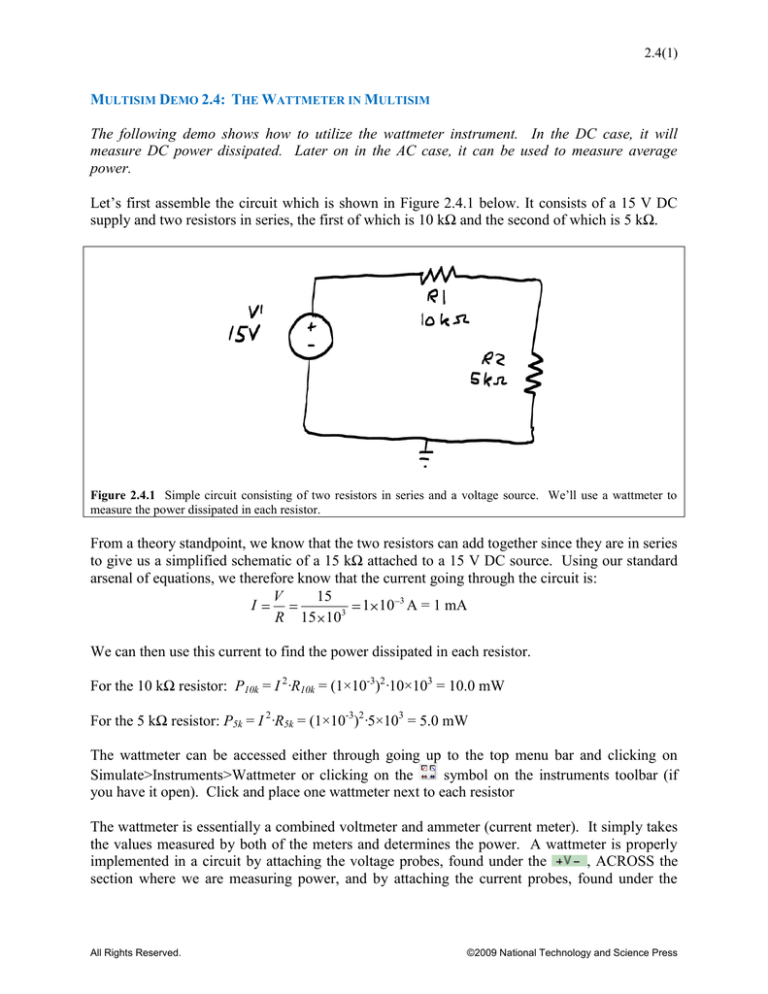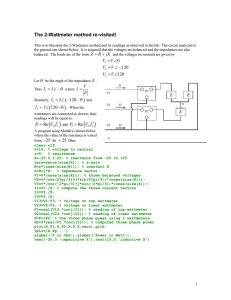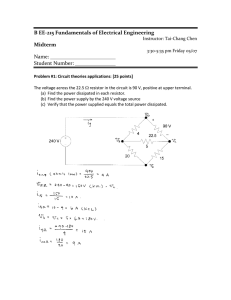
2.4(1)
MULTISIM DEMO 2.4: THE WATTMETER IN MULTISIM
The following demo shows how to utilize the wattmeter instrument. In the DC case, it will
measure DC power dissipated. Later on in the AC case, it can be used to measure average
power.
Let’s first assemble the circuit which is shown in Figure 2.4.1 below. It consists of a 15 V DC
supply and two resistors in series, the first of which is 10 kΩ and the second of which is 5 kΩ.
Figure 2.4.1 Simple circuit consisting of two resistors in series and a voltage source. We’ll use a wattmeter to
measure the power dissipated in each resistor.
From a theory standpoint, we know that the two resistors can add together since they are in series
to give us a simplified schematic of a 15 kΩ attached to a 15 V DC source. Using our standard
arsenal of equations, we therefore know that the current going through the circuit is:
V
15
I
1 10 3 A = 1 mA
3
R 15 10
We can then use this current to find the power dissipated in each resistor.
For the 10 kΩ resistor: P10k = I 2·R10k = (1×10-3)2·10×103 = 10.0 mW
For the 5 kΩ resistor: P5k = I 2·R5k = (1×10-3)2·5×103 = 5.0 mW
The wattmeter can be accessed either through going up to the top menu bar and clicking on
symbol on the instruments toolbar (if
Simulate>Instruments>Wattmeter or clicking on the
you have it open). Click and place one wattmeter next to each resistor
The wattmeter is essentially a combined voltmeter and ammeter (current meter). It simply takes
the values measured by both of the meters and determines the power. A wattmeter is properly
implemented in a circuit by attaching the voltage probes, found under the
, ACROSS the
section where we are measuring power, and by attaching the current probes, found under the
All Rights Reserved.
©2009 National Technology and Science Press
2.4(2)
, IN SERIES with the section where we are measuring power. For example, in order to
properly implement the wattmeter with resistor R1, the wattmeter should be attached like it is
shown in Figure 2.4.2, with the rest of the circuit attached to Nodes 1 and 3 just as if it were only
the resistor.
Figure 2.4.2 Properly hooking-up a wattmeter to measure the power dissipated in a resistor.
Using Fig. 2.4.2 as a guide, construct the circuit. In addition, note that the voltage source is 15 V,
but he default value for a DC voltage source in Multisim is 12 V, so this value must be changed.
To do this
1. Double click on the Voltage source, which should bring up the window in Fig. 2.4.3.
2. Make sure the Value tab is up front.
3. Change the Voltage (V): field to 15 V as shown in Fig. 2.4.3.
4. Click OK.
Figure 2.4.3 DC_POWER properties window showing 15 V for the Voltage (V) field.
All Rights Reserved.
©2009 National Technology and Science Press
2.4(3)
Once your circuit is constructed, it should look like Fig. 2.4.4.
Figure 2.4.4 Completed circuit with wattmeters incorporated properly into the circuit.
To bring up the all-important wattmeter window, double-click on the wattmeter, just like you
would for the multimeter (or any instrument as you will eventually find out). Bring up the
windows for both wattmeters. Just like any window, you can drag it around the screen. Drag
them and position them on the right side of the circuit so that they do not obscure anything in the
schematic. Your screen should look like Fig. 2.4.5.
Figure 2.4.5 How everything should look once the wattmeters windows are opened up and ready to view.
All Rights Reserved.
©2009 National Technology and Science Press
2.4(4)
To start measuring power, we need to start the interactive transient simulation by pressing either
button. The result is Fig. 2.4.6 below.
F5 or the
Figure 2.4.6 Measuring the power dissipated in both resistors.
As we can see in Figure 2.4.6, the power dissipated in the R1 is 10.000 mW and the power
dissipated in R2 is 5.000 mW. These values match up perfectly with the values calculated
towards the beginning of this Demo!
Note: The Wattmeter is not all-knowing. It only provides the magnitude of the power. This is
good and bad. It prevents one from hooking the terminals up with the wrong polarity and getting
the wrong magnitude of power, but it can also make us mistakenly think a component is
dissipating power when it may, in fact, may be supplying power. There’s simply no way of
knowing. A voltage source and a resistor may both show 55.0 mW on the wattmeter even though
the voltage source is supplying 55.0 mW (-55.0 mW) and the resistor is dissipating 55.0 mW
(+55.0 mW) Always keep in mind current directions and voltage polarities especially if you end
up having to measure the power in a dependent source since these can either dissipate or supply
power depending on how they are incorporated into the circuit.
In order to demonstrate the point stressed in the green box above, let’s now add a third wattmeter
to measure the power supplied by the 15 VDC source. In exactly the same way as you did with
the resistors, you can attach a wattmeter to measure the power supplied by the 15 VDC source.
As we can see in Figures 2.4.7 and 2.4.8, regardless of the way in which the Voltmeter probes
are attached, the same value of “15.000 mW” is read out. Hence, the wattmeter does not assign a
sign to power measurements.
The morale of the story is to be smart with the wattmeter and recognize that it will only tell you
the magnitude of the power either dissipated or supplied. It will not distinguish between the
two. You need to use your knowledge of circuits and other tools to figure that out.
All Rights Reserved.
©2009 National Technology and Science Press
2.4(5)
Figure 2.4.7 Using the standard notation which is stressed in the text, this circuit is actually measuring the negative
of the voltage. Consequently, the voltage and the current are both positive and + 15.000 mW is correct.
Figure 2.4.8 In this circuit, the voltage is measured properly with the + side of the voltmeter at the side where
current is flowing “in”. As a result, the voltage being measured between the + and – terminals is -15 V, but the
current is still + 1.000 mA. As a result, the answer should be – 15.000 mW, but still the Wattmeter only reads
15.000 mW.
All Rights Reserved.
©2009 National Technology and Science Press







